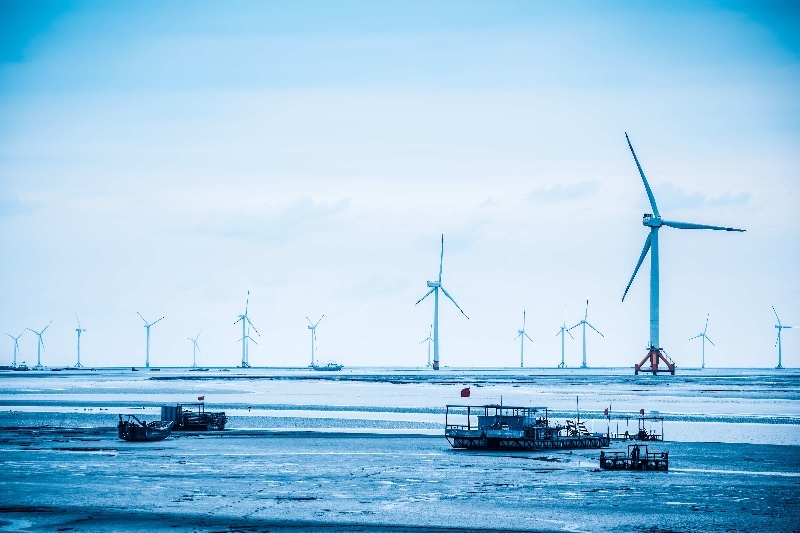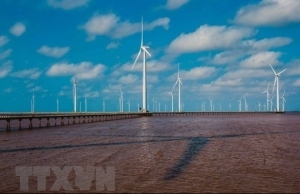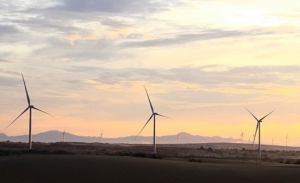Vietnam’s offshore wind realm remains in a muddle
The Central Economic Commission will authorise a complete evaluation of three years of Vietnam’s official energy development plan for the 2021-2030 period, according to the commission’s Deputy Chairman Dr. Nguyen Duc Hien earlier this month.
 |
| Vietnam’s offshore wind realm remains in a muddle (illustration photo/ Source: Shutterstock) |
According to Hien, unresolved policy is now the “greatest hurdle” to offshore wind energy development in Vietnam. Since the Power Development Plan VIII (PDP8) and marine spatial planning are still in the creation process, the distribution of marine areas for surveying offshore wind power development has not been specified in legal papers.
“In addition, the regulations governing the method of investor selection have not been modified effectively,” Hien said.
In recent years, Vietnam’s economic growth has resulted in a substantial rise in energy consumption and corresponding carbon emissions. According to a projection by Electricity of Vietnam for 2021-2025, the power production deficit could reach 27.7 billion kWh by 2025.
Unfortunate timing has hindered the plans from the start of the decade. In 2020, the La Gan offshore wind farm project, with a potential capacity of 3.5GW, was one of the first large-scale offshore wind power projects to be announced off the coast of Vietnam’s Ninh Thuan province. Nevertheless, Vietnam has been unable to make progress in the development of this energy source.
Mark Hutchinson, head of the Southeast Asia Task Group of the Global Wind Energy Council (GWEC), said that such timing was a formidable obstacle, but if Vietnam does not open the path to progress, it will be impossible to reach its 7GW offshore wind target by 2030.
“Offshore wind developers are primarily concerned with initiating the offshore wind sector via a variety of mechanisms. Rapid development and solicitation are the two primary approaches to jumpstarting this business,” Hutchinson said.
The draft PDP8 is being presented to the prime minister for review, and it is anticipated that the total wind power capacity will expand from roughly 4,000MW in 2022 to approximately 16,000MW of onshore and nearshore wind and nearly 7GW of offshore wind by 2030.
Using a fast development mechanism, the government may consider selecting a large-scale pilot project or using a particular set of processes for a given amount of capacity (3-4GW) to build projects in a shorter timeframe than typical, Hutchinson said.
This approach will assist projects in overcoming legislative obstacles and achieving a large enough deployment size to lower power production costs. If this option is selected, projects do not need to wait for marine spatial planning or the bidding procedure to be evaluated. The issue, though, is how to choose competent projects and developers.
A bidding method may also be a possibility, with the benefit that the project development process is open, transparent, competitive, and efficient. Yet, based on the experiences of the majority of nations that have applied, adopting this approach takes a long time.
Pham Nguyen Hung, deputy director of the Electricity and Renewable Energy Authority under the Ministry of Industry and Trade, described the implementation of 7GW of offshore wind power by 2030 as a big ask, adding that Vietnam was unfamiliar with this form of development.
“The legislative environment for offshore wind power growth is complex, including businesses such as oil and gas, maritime, fisheries, and most importantly, national security,” Hung said.
Investors are actively monitoring the construction and completion of Vietnam’s legislative framework for offshore wind generation.
“Vietnam can begin by authorising the PDP8 and exclusive offshore survey rights,” said Erik Kjaer, chief advisor of the Danish Energy Agency. “Danish investors anticipate that the Vietnamese government will soon publish a fair and unambiguous regulatory regime, which is necessary for the growth of the offshore wind.”
Vietnam must also emphasise marine spatial planning, Kjaer said. The government may enable a number of large-scale initiatives to be piloted for a certain amount of time and then use the acquired knowledge to establish an acceptable regulatory framework.
“Power purchase agreements are crucial for ensuring capital mobilisation and streamlining the licensing procedure at the national and provincial levels,” he added.
Bui Vinh Thang, GWEC national director for Vietnam, recommended the country begins with pilot projects to provide confidence and clarity, therefore luring investors for offshore wind generation. “This enables energy producers to estimate long-term earnings and identify local supply chain development plans, both of which are crucial to lowering the cost of offshore wind,” Thang said.
GWEC advises developing a 4GW capacity via a staged approach that includes pilot projects, projects selected through a selection process, or a hybrid selection and competition method. It said the government should adopt the roadmap for the commercialisation of offshore wind power by mid-2023 and establish the criteria for pilot projects. The first 1.5GW will be finished by the end of 2028, followed by the subsequent 2.5 GW by the end of 2029.
Simultaneously, pilot selection is the process of defining a set of project auction criteria and auctioning 3GW, with the remainder anticipated to be finished by the end of 2030.
Thang held that competitive projects might be on the grid by 2030 if offshore wind energy is developed step-by-step. He said that GWEC is willing to help the Vietnamese government find potential offshore wind power pilot projects, thereby ensuring that 4GW of offshore wind power would be authorised for financing before 2026.
 | Vietnam has dual opportunity from offshore wind power: Danish Ambassador Developing offshore wind power is a great dual opportunity for Vietnam, Danish Ambassador to Vietnam Nicolai Prytz told a seminar themed “Promoting Vietnam’s offshore wind power development: International practices and policy recommendations” in Hanoi on March 16. |
 | Vietnam has massive potential for offshore wind energy Vietnam has the potential to offer an economical and environmentally friendly energy source for economic growth, according to attendees at a recent workshop discussing offshore wind power. |
What the stars mean:
★ Poor ★ ★ Promising ★★★ Good ★★★★ Very good ★★★★★ Exceptional
Related Contents
Latest News
More News
- Heavy industries set for pilot greenhouse gas quotas (December 25, 2025 | 10:00)
- Swedfund invests in MSME growth and climate action in Vietnam (December 19, 2025 | 11:42)
- GreenYellow brings solar energy to light up remote schools in Tuyen Quang province (December 19, 2025 | 08:00)
- Charge+, Grab partner to develop EV charging network in Vietnam (December 18, 2025 | 17:11)
- Linking sci-tech and innovation to Vietnam’s net-zero future (December 18, 2025 | 14:31)
- Driving double-digit growth through green and circular transformation in Vietnam (December 17, 2025 | 09:00)
- Standard Chartered and ACCA deepen collaboration to develop Vietnam’s talent for a sustainable future (December 15, 2025 | 18:18)
- Schaeffler reports strong early output from Dong Nai solar project (December 12, 2025 | 15:16)
- Forestry conference highlights biodiversity and sustainability goals (December 09, 2025 | 13:35)
- Home Credit honoured among top 10 sustainable companies in trade and services (December 09, 2025 | 12:18)

 Tag:
Tag:





















 Mobile Version
Mobile Version